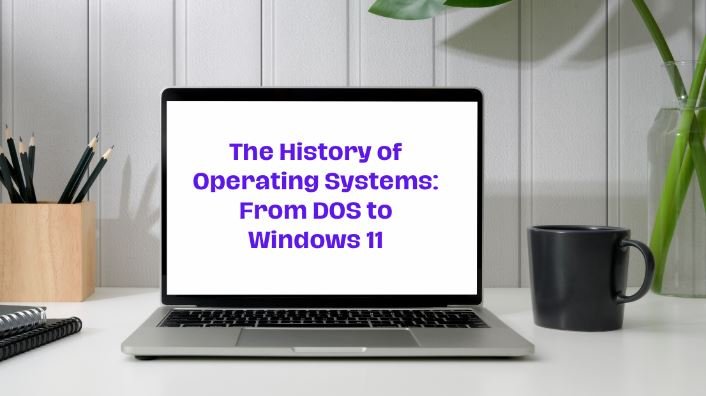Operating systems (OS) serve as the backbone of computer functionality, managing hardware and software resources while providing an interface for user interaction. The journey from early operating systems like DOS (Disk Operating System) to modern giants like Windows 11 highlights significant technological advancements and changing user needs over the decades.Let us explore the evolution of operating system.

The Era of DOS
Introduction of DOS
Introduced in 1981 by Microsoft, DOS was among the first widely-used operating systems for personal computers. Its command-line interface required users to input text commands to perform tasks, such as file management and program execution. Despite its lack of a graphical user interface (GUI), DOS was revolutionary for its time, providing a foundation for future operating systems.
Limitations and Legacy of DOS
DOS had significant limitations, including its single-tasking nature and lack of advanced memory management. However, it played a crucial role in the development of personal computing. It set the stage for more complex operating systems by introducing basic concepts of file systems and command structures.
The Introduction of Windows
Windows 1.0 to Windows 3.x
Microsoft introduced Windows 1.0 in 1985 as a graphical extension of DOS. While it was not a full operating system, it provided a GUI, making computers more accessible to the average user. Subsequent versions, like Windows 2.0 and Windows 3.x, improved usability and introduced features such as overlapping windows and more advanced graphics support.
Windows 95: A Game Changer
Released in 1995, Windows 95 marked a significant evolution. It integrated a GUI directly into the operating system, eliminating the need for DOS commands. Windows 95 introduced the Start menu, taskbar, and native support for long filenames. This version significantly enhanced user experience and set new standards for OS design.
Windows XP: A Leap Forward
Stability and Usability
Launched in 2001, Windows XP was renowned for its stability, user-friendly interface, and robust performance. It combined the best features of its predecessors, like Windows 98 and Windows 2000, into a single, unified system. The introduction of themes, better hardware support, and enhanced networking capabilities made Windows XP a favorite among users and businesses alike.
Longevity and Impact
Windows XP’s impact was profound, maintaining widespread use long after its release. Its longevity demonstrated the importance of a reliable and versatile operating system in both personal and professional environments. Despite the emergence of newer versions, many users remained loyal to XP due to its performance and familiarity.
The Modern Era: Windows 10 and Windows 11
Windows 10: A Unified Platform
Introduced in 2015, Windows 10 aimed to create a unified platform across all devices, including desktops, laptops, tablets, and smartphones. Key features included the return of the Start menu, the introduction of the Edge browser, and the integration of virtual desktops. Windows 10’s continuous update model ensured users always had the latest features and security enhancements.
Windows 11: The Future of Computing
Released in 2021, Windows 11 brought a fresh, modern design and improved performance. It featured a centered Start menu, new window management tools like Snap Layouts, and better support for touch, pen, and voice inputs. Windows 11 aimed to enhance productivity, gaming, and security, reflecting the evolving needs of modern users.
Conclusion
The evolution of operating system from DOS to Windows 11 showcases significant technological advancements and shifts in user expectations. Each iteration of Windows built on the strengths of its predecessors while introducing innovations that shaped the future of computing. Understanding this progression helps appreciate the complexity and capabilities of modern operating systems.

